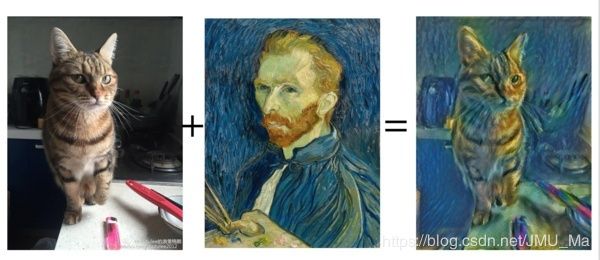卷积神经网络之迁移学习——迁移学习是什么?如何实现?应用方面
卷积神经网络之迁移学习
文章目录
- 卷积神经网络之迁移学习
- 什么是/为什么要迁移学习(Transfer Learning)
- 迁移学习介绍
- TensoFlow实现迁移学习
- 什么适合迁移
- 总结
什么是/为什么要迁移学习(Transfer Learning)
迁移学习(Transfer Learning):具体的讲就是,将一个问题上训练好的模型通过简单的调整使其适用于一个新的问题。一种学习对另一种学习的影响,或习得的经验对完成其他活动的影响。迁移广泛存在于各种知识、技能与社会规范的学习中。由于学习活动总是建立在已有的知识经验之上的,这种利用已有的知识经验不断地获得新知识和技能的过程,可以认为是广义的学习迁移; 而新知识技能的获得也不断地使已有的知识经验得到扩充和丰富。
通过迁移学习我们可以将已经学到的模型参数(也可理解为模型学到的知识)通过某种方式来分享给新模型从而加快并优化模型的学习效率不用像大多数网络那样从零学习(starting from scratch,tabula rasa)。
迁移学习介绍
通过对比LeNet-5模型和Inception-v3模型可以发现,卷积神经网络的模型的层数和复杂度都发生了巨大的变化。
| 年份 | 模型名称 | 层数 | Top5错误率 |
|---|---|---|---|
| 2012 | AlexNet | 8 | 15.3% |
| 2013 | ZF Net | 8 | 14.8% |
| 2014 | GoogLeNet | 22 | 6.67% |
| 2015 | ResNet | 152 | 3.57% |
发现模型的层数及复杂程度的增加,模型在ImageNet上的错误率也随之降低。然而,训练复杂的卷积神经网络需要非常多的标注数据。在现实生活中的,很难收集到如此多的标注数据,即使收集到,也需要花费大量的人力物力财力。而且海量的训练数据,要训练一个复杂的卷积神经网络也需要几天甚至几周的时间。为了解决出现的这些问题,迁移学习也随着出现。
TensoFlow实现迁移学习
我们从TensorFlow官网上下载本次所需要用到的数据集(http://download.tensoflow.org/example_images/flower_photo.tgz){接下来的代码和运行均基于Linux}
wget http://download.tensoflow.org/example_images/flower_photo.tgz
tar xzf flower_photo.tgz解压后的文件夹包括5个子文件夹,分别包括不同类的花,且其中的每一张图片都使RGB的,大小也不相同,下面的代码将演示如何将原始图形处理成所需要输入的数据。
import glob
import os.path
import numpy as np
import tensorflow as tf
from tensorflow.python.platform import gfile
# 原始输入数据的目录,这个目录下有5个子目录,每个子目录底下保存这属于该
# 类别的所有图片。
INPUT_DATA = 'path/to/datasets/flower_photos'
# 输出文件地址。我们将整理后的图片数据通过numpy的格式保存。
OUTPUT_FILE = 'path/to/datasets/flower_processed_data.npy'
# 测试数据和验证数据比例。
VALIDATION_PERCENTAGE = 10
TEST_PERCENTAGE = 10
def create_image_lists(sess, testing_percentage, validation_percentage):
sub_dirs = [x[0] for x in os.walk(INPUT_DATA)]
is_root_dir = True
# 初始化各个数据集。
training_images = []
training_labels = []
testing_images = []
testing_labels = []
validation_images = []
validation_labels = []
current_label = 0
# 读取所有的子目录。
for sub_dir in sub_dirs:
if is_root_dir:
is_root_dir = False
continue
# 获取一个子目录中所有的图片文件。
extensions = ['jpg', 'jpeg', 'JPG', 'JPEG']
file_list = []
dir_name = os.path.basename(sub_dir)
for extension in extensions:
file_glob = os.path.join(INPUT_DATA, dir_name, '*.' + extension)
file_list.extend(glob.glob(file_glob))
if not file_list: continue
print("processing:", dir_name)
i = 0
# 处理图片数据。
for file_name in file_list:
i += 1
# 读取并解析图片,将图片转化为299*299以方便inception-v3模型来处理。
image_raw_data = gfile.FastGFile(file_name, 'rb').read()
image = tf.image.decode_jpeg(image_raw_data)
if image.dtype != tf.float32:
image = tf.image.convert_image_dtype(image, dtype=tf.float32)
image = tf.image.resize_images(image, [299, 299])
image_value = sess.run(image)
# 随机划分数据聚。
chance = np.random.randint(100)
if chance < validation_percentage:
validation_images.append(image_value)
validation_labels.append(current_label)
elif chance < (testing_percentage + validation_percentage):
testing_images.append(image_value)
testing_labels.append(current_label)
else:
training_images.append(image_value)
training_labels.append(current_label)
if i % 200 == 0:
print(i, "images processed.")
current_label += 1
# 将训练数据随机打乱以获得更好的训练效果。
state = np.random.get_state()
np.random.shuffle(training_images)
np.random.set_state(state)
np.random.shuffle(training_labels)
return np.asarray([training_images, training_labels,
validation_images, validation_labels,
testing_images, testing_labels])
with tf.Session() as sess:
processed_data = create_image_lists(sess, TEST_PERCENTAGE, VALIDATION_PERCENTAGE)
# 通过numpy格式保存处理后的数据。
np.save(OUTPUT_FILE, processed_data)
运行以上代码可以将图片jpg输入成数据,且均为Inception-3所需要的299x299x3的数字矩阵。
再载入我们所需要的模型~~incep-3模型。当数据集和模型都准备好,我们用接下来的代码实现迁移学习。
import glob
import os.path
import numpy as np
import tensorflow as tf
from tensorflow.python.platform import gfile
import tensorflow.contrib.slim as slim
# 加载通过TensorFlow-Slim定义好的inception_v3模型。
import tensorflow.contrib.slim.python.slim.nets.inception_v3 as inception_v3
# 处理好之后的数据文件。
INPUT_DATA = 'path/to/datasets/flower_processed_data.npy'
# 保存训练好的模型的路径。
TRAIN_FILE = '/path/to/save_model'
# 谷歌提供的训练好的模型文件地址。
CKPT_FILE = 'path/to/datasets/inception_v3.ckpt'
# 定义训练中使用的参数。
LEARNING_RATE = 0.0001
STEPS = 300
BATCH = 32
N_CLASSES = 5
# 不需要从谷歌训练好的模型中加载的参数。
CHECKPOINT_EXCLUDE_SCOPES = 'InceptionV3/Logits,InceptionV3/AuxLogits'
# 需要训练的网络层参数明层,在fine-tuning的过程中就是最后的全联接层。
TRAINABLE_SCOPES='InceptionV3/Logits,InceptionV3/AuxLogit'
#获取所有需要从谷歌训练好的模型中加载的参数。
def get_tuned_variables():
exclusions = [scope.strip() for scope in CHECKPOINT_EXCLUDE_SCOPES.split(',')]
variables_to_restore = []
# 枚举inception-v3模型中所有的参数,然后判断是否需要从加载列表中移除。
for var in slim.get_model_variables():
excluded = False
for exclusion in exclusions:
if var.op.name.startswith(exclusion):
excluded = True
break
if not excluded:
variables_to_restore.append(var)
return variables_to_restore
def get_trainable_variables():
scopes = [scope.strip() for scope in TRAINABLE_SCOPES.split(',')]
variables_to_train = []
# 枚举所有需要训练的参数前缀,并通过这些前缀找到所有需要训练的参数。
for scope in scopes:
variables = tf.get_collection(tf.GraphKeys.TRAINABLE_VARIABLES, scope)
variables_to_train.extend(variables)
return variables_to_train
def main():
# 加载预处理好的数据。
processed_data = np.load(INPUT_DATA)
training_images = processed_data[0]
n_training_example = len(training_images)
training_labels = processed_data[1]
validation_images = processed_data[2]
validation_labels = processed_data[3]
testing_images = processed_data[4]
testing_labels = processed_data[5]
print("%d training examples, %d validation examples and %d testing examples." % (
n_training_example, len(validation_labels), len(testing_labels)))
# 定义inception-v3的输入,images为输入图片,labels为每一张图片对应的标签。
images = tf.placeholder(tf.float32, [None, 299, 299, 3], name='input_images')
labels = tf.placeholder(tf.int64, [None], name='labels')
# 定义inception-v3模型。因为谷歌给出的只有模型参数取值,所以这里
# 需要在这个代码中定义inception-v3的模型结构。虽然理论上需要区分训练和
# 测试中使用到的模型,也就是说在测试时应该使用is_training=False,但是
# 因为预先训练好的inception-v3模型中使用的batch normalization参数与
# 新的数据会有出入,所以这里直接使用同一个模型来做测试。
with slim.arg_scope(inception_v3.inception_v3_arg_scope()):
logits, _ = inception_v3.inception_v3(
images, num_classes=N_CLASSES, is_training=True)
trainable_variables = get_trainable_variables()
# 定义损失函数和训练过程。
tf.losses.softmax_cross_entropy(
tf.one_hot(labels, N_CLASSES), logits, weights=1.0)
total_loss = tf.losses.get_total_loss()
train_step = tf.train.RMSPropOptimizer(LEARNING_RATE).minimize(total_loss)
# 计算正确率。
with tf.name_scope('evaluation'):
correct_prediction = tf.equal(tf.argmax(logits, 1), labels)
evaluation_step = tf.reduce_mean(tf.cast(correct_prediction, tf.float32))
# 定义加载Google训练好的Inception-v3模型的Saver。
load_fn = slim.assign_from_checkpoint_fn(
CKPT_FILE,
get_tuned_variables(),
ignore_missing_vars=True)
# 定义保存新模型的Saver。
saver = tf.train.Saver()
with tf.Session() as sess:
# 初始化没有加载进来的变量。
init = tf.global_variables_initializer()
sess.run(init)
# 加载谷歌已经训练好的模型。
print('Loading tuned variables from %s' % CKPT_FILE)
load_fn(sess)
start = 0
end = BATCH
for i in range(STEPS):
_, loss = sess.run([train_step, total_loss], feed_dict={
images: training_images[start:end],
labels: training_labels[start:end]})
if i % 30 == 0 or i + 1 == STEPS:
saver.save(sess, TRAIN_FILE, global_step=i)
validation_accuracy = sess.run(evaluation_step, feed_dict={
images: validation_images, labels: validation_labels})
print('Step %d: Training loss is %.1f Validation accuracy = %.1f%%' % (
i, loss, validation_accuracy * 100.0))
start = end
if start == n_training_example:
start = 0
end = start + BATCH
if end > n_training_example:
end = n_training_example
# 在最后的测试数据上测试正确率。
test_accuracy = sess.run(evaluation_step, feed_dict={
images: testing_images, labels: testing_labels})
print('Final test accuracy = %.1f%%' % (test_accuracy * 100))
if __name__ == '__main__':
tf.app.run()最后程序运行完成后可以得到以下结果:
Step0: Validation accuracy:22.8%
Step30: Validation accuracy:29.6%
Step60: Validation accuracy:63.2%
Step90: Validation accuracy:81.2%
Step120: Validation accuracy:88.6%
...
Step299: Validation accuracy:91.5%
Final test accuracy = 91.9%什么适合迁移
在一些学习任务中有一些特征是个体所特有的,这些特征不可以迁移。而有些特征是在所有的个体中具有贡献的,这些可以进行迁移。有些时候如果迁移的不合适则会导致负迁移,例如当源域和目标域的任务毫不相关时有可能会导致负迁移。
总结
总之,迁移学习将成为下一个令人兴奋的研究方向。特别是在一些数据集具有广泛特征的,例如正在医学影像方面、图像风格替换等等。
